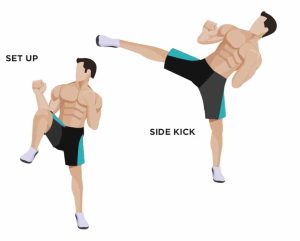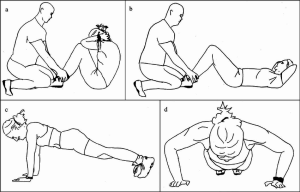Introduction: top 10 high-intensity workouts explosive results
Let’s talk about top 10 high intensity workouts explosive results, what are they, why you’d want to do it, who can do it, and how you can do it. There are many misconceptions out there, so we’re going to straighten them all out for you. We are going to give you best examples of top 10 high-intensity interval training exercises that you can do, and then we are going to tell you the number one exercise that just blows everything else away.
What are High intensity workouts?
First, let me explain what High intensity workouts are. It’s not where you go to the gym and work out really hard for 45 minutes, even though that feels like high intensity. That is not what we’re talking about. Just like the name says, it is intense, meaning you have to get up to a super high intensity, so high that you cannot sustain it for more than seconds to maybe a minute. Therefore, it is short and very time-saving.
If you can do it for 30 minutes, it’s not high-intensity interval training.
An interval simply means that you’re varying the intensity; you alternate between high intensity and lower intensity or resting periods. It’s a super high-intensity, short-duration type of exercise that produces a seriously high growth hormone spike and other benefits. The cool thing about it is because you’re using this high-intensity short-duration exercise, you’re not going to be doing a tremendous amount of it, so it’s a quicker workout which takes less time for those busy people. But let’s dissect what workouts really is. You have four parts: duration or time, intensity of the exercise, recovery after the exercise, and how many times you do this specific exercise, how long you do it, how long you rest, and how many repetitions you’re going to do.
So typically, when you’re doing HIIT or high-intensity interval training, you’re doing it only for like 30 to 60 seconds, maybe a little bit longer, maybe a little bit shorter, and then you’re resting between 30 seconds or usually like a minute to five minutes. Then you’re doing this three times to seven times, and as far as per week, you might do it once, twice, or three times per week. That’s the pattern.
Why does high-intensity-workouts work?
Now, let’s discuss why high-intensity interval training works. We want to look at these variables a little bit deeper. Intensity is the key factor in exercise that stimulates muscle growth and also stimulates growth hormone. If you have a low intensity and high duration, a long period of time of exercise, like jogging for 45 minutes, you will not stimulate growth hormone nearly as strongly as compared to a short duration, high-intensity workout.
Recovery is an individual thing, and it’s essential to consider. Each person has a different ability to recover, and there’s a really good test I’m going to recommend that you do to determine your recovery. However, there are certain precautions. You don’t want to do HIIT if you have injuries because it’s high intensity. You also don’t want to do it if you have poor recovery, and I’m going to show you a good test to figure that out. You don’t want to do it if you have heart problems because doing this intensity exercise without supervision when you have a heart problem could be an issue.
Benefits of HIIT Training
So why is there all this talk about high-intensity interval training? Because when we look at the benefits of exercise and understand what they truly are, there are hormonal benefits, fitness benefits, circulation benefits, and some people believe that burning calories is also a benefit. You get all of these benefits in less time. Hormonal benefits mean that with high intensity, you make something called growth hormone and brain-derived neurotrophic factor (BDNF), pretty much in proportion to how intense the exercise is. These hormones are extremely beneficial; they are muscle promoting and brain promoting. You cannot make new brain cells or new synapses without human growth hormone and BDNF. But with enough of those and the right nutrition and circumstances, you can actually make new brain tissue. High intensity means you make more of these beneficial hormones in direct proportion to how intense the exercise is.
That also has to do with fitness; the fitness benefits are pretty much proportional to the intensity. You get circulation benefits even though the duration is shorter, and we’ll talk more about that. You can get all these benefits in much, much, much shorter time than it would take to go to the gym, go to a spin class, or do aerobics three, four, five, six days a week.
Who shouldn’t do high-intensity-workouts?
So this is what you’d want to do. First, check your resting pulse rate, and you can get a pulse meter by checking your pulse on your fingertip. Normally, an average pulse rate is about 72. If your pulse rate is high, like 90, 100, higher than that, you need to check that out because that’s not normal.
Now, if this top number and the bottom number come out to be 13 to 20, there’s a moderate risk of a problem. If it’s 20 to 30, you’re okay, and if it’s less than 30, you’re in pretty good shape. You ideally want that pulse rate to come all the way down to the resting pulse rate.
Who can do high-intensity-workouts?
The next question is who can do this? Well, pretty much everyone. However, we have to make sure that we do it within the limits of our fitness level.
Everyone can do it, but if you have a disease, if you have pain, if you are extremely unfit, then you need to be aware of your situation and move forward very carefully and gradually. You have to be cautious not to jeopardize your health. If you have a heart condition or some other disease, you need to consult with the doctor managing that disease before you engage in any of this. If you have pain, you need to accommodate the exercises to those you can handle with that pain. If you’re unfit, you have to move forward very slowly.
What happens when you do high-intensity-workouts?
Now when you start an exercise and raise your pulse rate, you’re really stimulating the sympathetic nervous system, which is the fight or flight mechanism. The second you stop working out, the parasympathetic nervous system takes over and starts to push your pulse rate down to the resting pulse rate.
Here’s our top 10 high-intensity workouts explosive results
Now let’s look at my personal selection of best workout examples:
- Plyometrics:
- What it is: Plyometrics involves sudden bursts of energy, like jumping on a platform or doing explosive movements.
- How to do it: You start with a slight bend in your knees, then jump up as high as you can, landing softly. This works your leg muscles and is great for building power.
- Tips: Always land softly to protect your joints.

- Jumping Rope:
- What it is: Jumping rope is a classic and effective high-intensity workout that burns fat.
- How to do it: Hold the jump rope handles, jump over the rope as it swings under your feet, and keep going.
- Tips: Jump lightly and use your wrists to turn the rope.

- Burpees:
- What it is: Burpees are full-body, high-intensity exercises perfect for HIIT workouts.
- How to do it: Start by standing, then drop into a squat position, kick your feet back, do a push-up, bring your feet back to the squat, and jump up.
- Tips: It’s a challenging exercise, so start slowly and get the technique right first.

- Kickboxing:
- What it is: Kickboxing involves explosive movements like kicking and punching.
- How to do it: Follow a kickboxing routine that includes kicks and punches.
- Tips: Focus on proper form and include rest intervals to avoid getting too tired.

- Spin Bike:
- What it is: Riding a stationary spin bike provides a great cardiovascular workout with short bursts of high intensity.
- How to do it: Pedal as fast as you can during the intense intervals, then slow down during the rest periods.
- Tips: Adjust the resistance to match your fitness level.

- Kettlebell:
- What it is: Kettlebell workouts incorporate resistance training into HIIT routines.
- How to do it: Use a kettlebell and perform exercises like swings, squats, and presses.
- Tips: Choose an appropriate kettlebell weight and learn proper form.

- Bulgarian Bag:
- What it is: A dynamic sandbag workout that engages your entire body.
- How to do it: Lift, swing, and carry the Bulgarian bag in various motions to work different muscles.
- Tips: Start with a lighter bag to get used to the movements.

- CrossFit:
- What it is: CrossFit is known for its intensity, involving various exercises and challenges.
- How to do it: Follow CrossFit workouts led by trained instructors.
- Tips: CrossFit can be demanding, so ensure you receive proper guidance and be cautious, especially as you age.

- Cross-country skiing:
- What it is: This workout uses machines to simulate cross-country skiing with high-intensity potential.
- How to do it: Follow the skiing motion on the machine with intensity during the working phase.
- Tips: Use the machine correctly and adjust resistance to your fitness level.

- Push-ups and Sit-ups:
- What it is: These are effective bodyweight exercises for HIIT.
- How to do it: For push-ups, start in a plank position, lower yourself, then push up. For sit-ups, lie on your back, bend your knees, and sit up.
- Tips: Perform these exercises with proper form to avoid injury.

How to Do HIIT
Now, how do you do HIIT correctly so that you get these hormonal benefits, the fitness benefit, and that you do it within a short and convenient time frame? The first thing you need to know is that it’s about producing lactic acid. If you exercise at a level below which you produce lactic acid, also known as aerobic, there will be none or negligible hormonal benefits. As far as growth hormone, your body only makes growth hormone in response to a challenge. But it only makes extra growth hormone in response to a challenge. This is all about challenging the body.
When we talk about lactic acid, that means it’s going to hurt; it’s going to burn, and you need to push yourself. However, the beauty is that most people are very willing to push themselves if it’s for a short time. We’re talking seconds here. You can do this on a stationary bike, walking, jogging, running, body circuits, burpees, or using a rowing machine, and we’ll talk about some of those. The activity doesn’t matter so much, but the principle is as follows.
You start by warming up with a 5 to 10 minute warm-up, just to get your joints ready, your circulation going, your brain engaged, and all that good stuff. You still want to be in an aerobic range during the warm-up. Your heart rate is probably going to be below 120 or so. Once you start your first interval, you go all out, hitting it really hard for 20 to 60 seconds, depending on the activity.
If you’re on a stationary bike, then your legs are going to start burning really fast, and you’ll probably tend to go into a shorter interval. However, if you’re doing something like walking, jogging, or running, you might go for a longer interval. The shorter you do it, the more repetitions you’ll do; the longer you do it, the fewer repetitions you need to do. Here’s what it might look like: you go all out for 30 seconds, and your heart rate starts around 120. You add or subtract based on your own numbers, but your heart rate will get up to 140 or so in the first 30 seconds. You give yourself a rest period of 20 to 60 seconds, but not much longer to keep your heart rate from dropping too low. You depend on the previous lactic acid to not go away entirely before starting the next one. That’s how you keep pushing your heart rate higher and higher.
Why Do HIIT
Now, why wouldn’t you just want to do one interval of three minutes? Well, you could, and it would still be beneficial, but it won’t have the same benefit of each period pushing the next higher. With each resting period, your body will up-regulate its circulation, open up capillaries, up-regulate enzymes and the machinery for oxygen utilization and energy production. This works much better with intervals like this.
Then you rest for about 30 seconds, and when you start over again, your heart rate might be at 130. It’s higher than it was, and because of that, and because you have some lactic acid, the next interval is going to take you higher than the previous one. You might reach a heart rate of 150, for example. You go 30 seconds, you rest 30 seconds, and now your heart rate is going to drop but not as much as it dropped from the previous one. Then you hit it again for 30 seconds all-out, and you might hit 160. You rest another 30 seconds and hit it one more time. Now, you might have reached your maximum heart rate, but you might get a few more points depending on your fitness level and how hard you push yourself. The goal is to get up to your maximum heart rate. Your maximum heart rate is different for everyone, but the rough rule of thumb is to start with 220 and subtract your age. For example, if you’re 55 years old, your maximum heart rate should be around 165. If you hit once between 160 and 165, you would be happy. You’d be done for that day. You can later try to push it higher and see where your actual level is.
How Often to Do high-intensity workouts?
Now, how often should you do this? Some suggest doing it every day, but that’s not a good idea. The half-life of growth hormone is short, only 20 to 30 minutes. What lasts are the secondary effects, which go on for days. Growth hormone is mainly released during sleep, up to 85% of it. While the half-life is short, doing HIIT improves growth hormone release during your sleep cycle. Exercise is a stress that breaks you down; it doesn’t make you stronger or feel better. What makes you feel better and builds muscle is when the body repairs the damage caused by exercise. The body repairs the damage because you’ve challenged it, worn down the muscle, or broken a few muscle fibers. This process releases a lot of growth hormone. So, full recovery is essential between the days you do high-intensity training. The rule is to have two days of complete rest, meaning you do this no more than two to three times a week for optimal benefits. As you get busier, it’s hard to find time to spend hours at the gym, but you can still get the benefits by condensing it into less than thirty minutes, two to three times a week. If you found this video informative, you may enjoy the next one. Thank you so much for watching, and I’ll see you next time.

